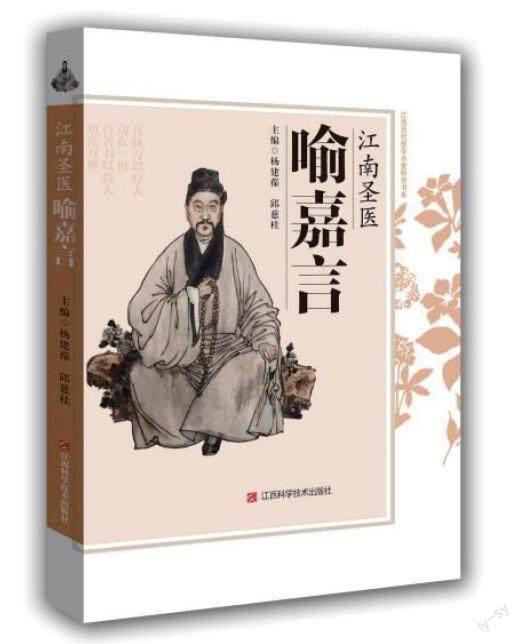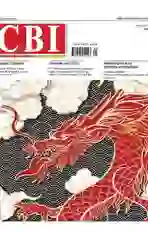Jiangnan Medical Sage Yu Jiayan
2024-04-26



Jiangnan Medical Sage Yu Jiayan is the first book of the Jiangxi Medical Masters Research Book Series. The book comprehensively researches the life deeds and medical contributions of Yu Jiayan, one of the three famous doctors in the early Qing Dynasty. The publication of this book provides important documentary value for Yu Jiayans research on medicine, history, literature, and sociology, and at the same time, enriches the research results of Jiangxis local medical celebrities and local medical culture.
Yang Jianbao
Yang Jianbao is a doctor and writer. He graduated from Jiangxi University of Traditional Chinese Medicine, and was the director of the Dermatology Department of the Third Affiliated Hospital of Nanchang University and vice chairman of the Nanchang Writers Association.
Yu Jiayan originally took the road of the imperial examination. But as there was already no hope of finding an official position, he took refuge in a religious life, concentrated on the meditation of Zen, and then practiced medicine as a way of saving the world. From Confucianism to Buddhism and then to medicine, he traveled all his life, lived in no fixed place, and made friends in various fields in the process of walking around. He was knowledgeable and talented. Yu Shi has certain achievements in Confucianism, Taoism, Buddhism, medicine, and Go and was listed as one of the “Fourteen Saints” of the early Qing Dynasty by Yan Ruoxuan, a famous scholar in the early Qing Dynasty. “The twelve saints, Qian Muzhai, Feng Dingyuan, Huang Nanlei, Lü Wancun, Wei Shuzi, Wang Juwen, Zhu Xichang, Gu Ranfen, Gu Ningren, Du Yuhuang, Cheng Zishang, Zheng Ruqi, and Yu Jiayan and Huang Longshi, a total of fourteen people, called saints.” Qian Qianyi once commented in his book Muzhai Election Matters that Yus medical technique is “divine art, called holy medicine.”
Yu Jiayan has high medical ethics and is a doctor of chivalry and sympathy. He would often rather offend people to make saving the lives of patients his responsibility and eliminate the interference of quacks to save people. He is indeed a doctor with superb medical skills, fantastic decision-making ability, and sincere compassion. Fu Shan, a famous doctor in the early Qing Dynasty who was born after him, took Yu Jiayans conduct as the standard for his medical practice. Qian Qianyi praised him and said, “I met Mr. Yu Jiayan in my later years. He is like how Lu Zhaolin praised Sun Simiao. It is said that his thought runs through ancient and modern times, and his scholarship is exhaustive of astronomy, the calendar, and divination. His superb view of the eternal and unchanging nature of all things in the world is just like Zhuangzi in ancient times. His profound study and dedication are just like Vimalakirti in the present.”
Yu Jiayan lived between the period of Wanli in the Ming Dynasty (1573--1620) and the period of Kangxi in the Qing Dynasty (1662--1722). He went through the path of “Confucianism to Zen and Zen to medicine” and finally took the study of medicine as his lifelong career. He has profound knowledge of the basic theory of Chinese medicine, typhoid fever, warm disease, miscellaneous diseases, gynecology, and pediatrics, and his academic ideas have had a far-reaching impact on future generations. However, there has always been a lack of comprehensive and detailed discussion of his life and masterpieces, nor has there been a complete biography.
In the thirteenth year of the Wanli (1585), Yu Jiayan was born in Xinjian County, Jiangxi Province. His original given name was Yu Chang, and his style name was Jiayan. As Xinjian is located west of Nanchang, the literati in former times sometimes liked to call it Xichang (the west of Nanchang in Chinese). Yu Jiayan called himself the old man of Xichang in his later years, which means he did not forget his hometown. As for his family and residence, there is no verification.
Yu was intelligent and dashing, able to compose articles at an early age. He learned Confucianism after he came of age to prepare for the imperial examination. His remarkable energy well surpassed his peers. He was well-read and pretentious. He was friends with Chen Jitai from Linchuan, with whom he traveled around.
Although talented and ambitious, Yu was not very proud in terms of career path, and in 1630, the 45-year-old Yu Jiayan won a vice-tribute and entered the Imperial Academy (Guozijian) in Beijing, hoping to make a great difference. During his stay in Beijing, he wrote to the imperial court stating his views on state affairs, but his ideas were never adopted and taken seriously, so he had to return with despair.
After returning home from Beijing, Yu felt that his political ambitions could not be realized. Coupled with changes in his family, he became depressed, and when he was about forty years old, he became a monk. While studying Buddhism, he also delved into medicine, assiduously studying classic works of Chinese medicine such as Neijing and Shanghan Lun, as well as famous works of traditional Chinese medicine throughout the ages. Even if he became a monk, he still remembered the phrase, “If you choose not to be a good chancellor, then be a good doctor.” The idea of saving the world and saving people greatly influenced his motivation to study medicine. Soon afterward, he grew his hair and went down the mountain to practice medicine as his profession until the end of the year.
Jiangxi is a large cultural province. Since the establishment of the capital in the early years of the Western Han Dynasty, it has lasted more than 2,200 years. Dating back 40,000 to 50,000 years, ancient stone tools have been found in Yongshan Cave in Leping, Northeast Jiangxi. The excavation of the bronze wares of the Shang Tomb in Dayangzhou Town, Xingan County in 1989 shows strong physical data that 3,100--3,200 years ago, Jiangnan bred a highly developed bronze culture comparable to the Central Plains culture. The thousand-year-old theory of “monism of the formation of Chinese national culture” that originated only from the Yellow River was thus given away. The Yangtze River and the Yellow River are both the mother rivers of the Chinese nation and together gave birth to the great Chinese nation; the “dualism of the formation of Chinese national cultural generation” has been widely recognized by academics.
This god-blessed land of prosperity has given birth to a broad and profound Gan cultural system and nourished generations of the Chinese nation. In general, Gan culture is a subsystem of Chinese national culture. Developed for a long time, it has derived a series of its own cultural branches, forming a rich and well-defined network.
Geographically, Gan culture includes many subsystems such as Xunyang culture, Yuzhang culture, Linchuan culture, Luling culture, Yuanzhou culture, Gannan Hakka culture, and so on.
From the perspective of playing an important role in social and economic development, Jiangxis copper culture, porcelain culture, academy culture, literature, art, science and technology, philosophy, etc., each constitute a relatively independent system, and they play a significant role in promoting the cultural history of the Chinese nation.
Copper culture: From the Bronze Age to today, the production and use of copper in Jiangxi has always occupied an important position in national economic life; Porcelain culture: Jingdezhen porcelain production and art have had an extremely important impact on the development of Chinese culture, and have been spread to the world as a symbol of Chinese culture; Academy Culture: Since the Tang Dynasty, Jiangxi has gradually become the center of feudal education and cultural dissemination in China, and is the origin of ancient Chinese academies. Jiangxi has Chinas earliest private academies— Xunyang Chens Academy and Dongjia Academy in the late Tang Dynasty. There are many official and private schools, and the quantity, quality, scale and influence of the academies are first in the country, becoming a wonder that anyone who studies Chinese culture cannot ignore.
Neo-Confucianism: In the Song Dynasty, great philosophers in Jiangxi sprang up one after another, and the academic atmosphere was highly prosperous. Great scholars like Zhu Xi, Cheng Yi, Cheng Hao, and Lu Jiuyuan were the most influential thinkers in Chinese society in the late feudal period. Neo-Confucianism originated and was stereotyped in Jiangxi, China.
However, in the existing research on Gan culture, there is a defect; that is, our past research lacks the discussion of an important cultural phenomenon in Gan culture — “Xinglin culture” and neglected the research of Mr. Yu Jiayan, a famous Chinese medicine scientist who has made great contributions to the history of Chinese medicine.
The famous Capital of Traditional Chinese Medicine — Zhangshu, is located in Jiangxi. As the saying goes, “Medicine that hasnt passed Zhangshu does not work its magic,” which shows the important position of Jiangxis medicine culture in the history of Chinese medicine. Mr. Yu Jiayan, a famous doctor of Jiangxi Province, has made great achievements and praised history with his three books, Shang Lun Pian, Yi Men Fa Lü, and Yu Yi Zhang. Traditional Chinese medicine is unique in the history of human culture and has maintained its unique and irreplaceable position from ancient times to the present. The Chinese “Xinglin culture,” synthesized by traditional Chinese physicians and traditional Chinese medicine, is an important part of the local culture with Chinese characteristics and an important branch of the Gan cultural system.
The study of the “Yu Jiayan Phenomenon” complements an important link in the research chain of Gan culture, expands the field of Gan culture research, enriches the connotation of Gan culture, and will play an important role in deepening our understanding of the significance and characteristics of Gan culture.
Jiangnan Medical Sage
Yu Jiayan
Yang Jianbao, Qiu Cigui
Jiangxi Science & Technology Publishing House
September 2019
68.00 (CNY)
杂志排行
中国新书(英文版)的其它文章
- Wen Zhengming: A Suzhou Elegance Legend
- The Legend of the City
- Candlelight Tales in the Whitewashed Hall
- The China Path -- A Unique Modernization Journey (English Edition) Published and Distributed
- 2023 China Shanghai International Children’s Book Fair Concludes
- The 11th China Enterprise Global Image Summit Was Held
